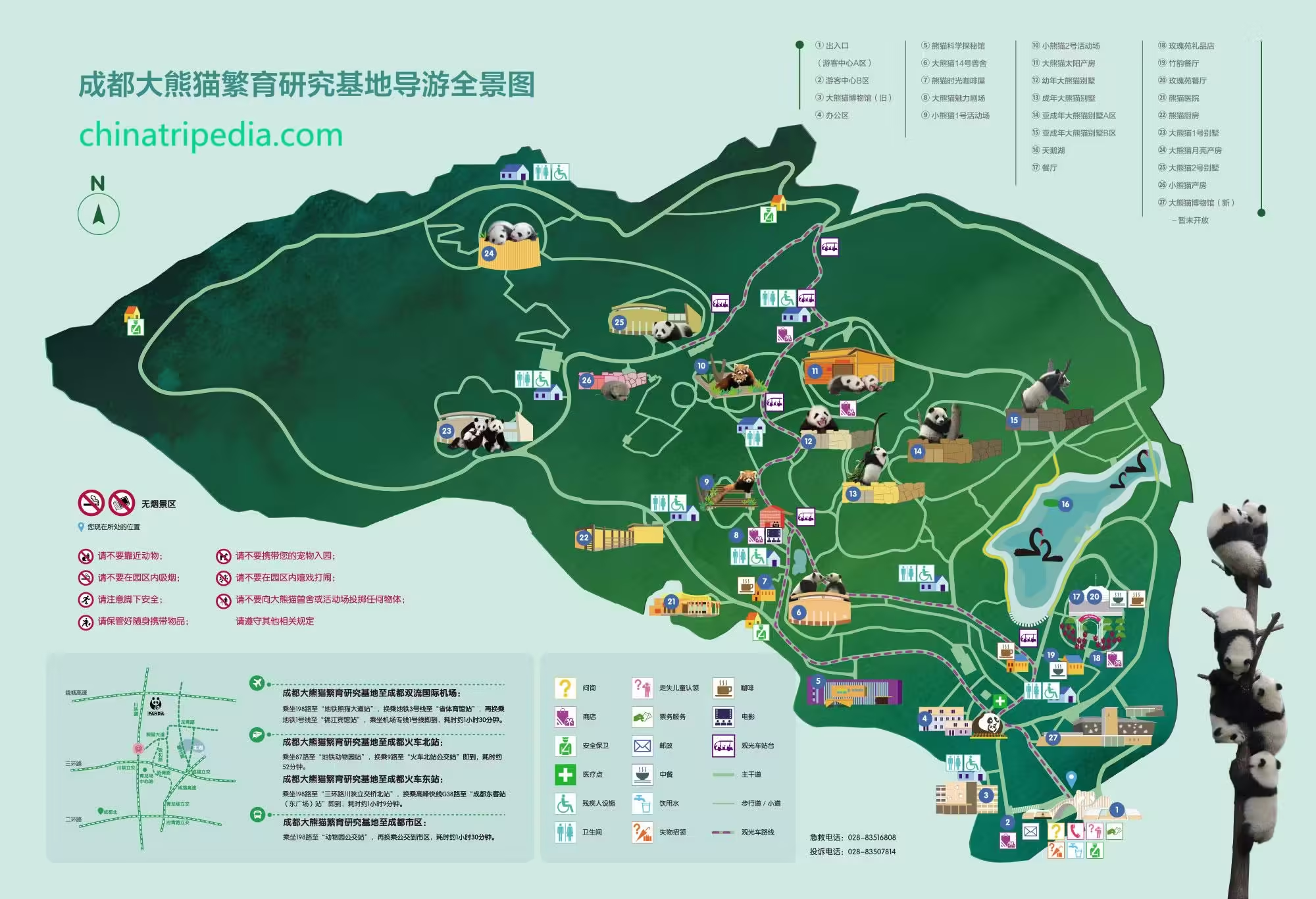The Chengdu Research Base of Giant Panda Breeding (成都大熊猫繁育研究基地) is a non-profit organization located in Chengdu, Sichuan Province, China. Founded in 1987, the base’s primary goal is to promote the conservation of the endangered giant panda species through scientific research, breeding programs, and public education.
The base covers an area of 600 acres and serves as a home to over 100 giant pandas. It is one of the most important institutions in the world for the preservation and study of these beloved creatures. Visitors to the base can observe the pandas in their natural habitats and learn about the breeding process and conservation efforts.
In addition to the pandas, the base also has several other animal species, including red pandas, black-necked cranes, and peacocks. The base also features a research center, a panda museum, and a veterinary hospital.
Overall, the Chengdu Research Base of Giant Panda Breeding is an incredible organization dedicated to the conservation of the giant panda species and the education of the public about these beloved animals.
Table of Contents
- Basic Information
- Location and Transportation
- Highlights of Chengdu Panda Base
- Map and Recommended Route
- Vlog about Chengdu Panda Breeding Center
- Useful tips from Genuine Reviews
- Other Places to See Panda in Chengdu
Basic Information
| Website | http://www.panda.org.cn/ |
| Estimated Length of Tour | Over 3 hours |
| Ticket Price | 55 RMB |
| Opening Hours | 7.30 – 17.00; Last admission: 18.00 Panda Museum closes on Monday Panda Tower closes on Tuesday |
Location and Transportation
The Chengdu Research Base of Giant Panda Breeding is located in the northern suburbs of Chengdu, the capital city of Sichuan Province, China. Specifically, it is situated in the Futou Mountain area of the Chenghua District, approximately 10 kilometers (6 miles) from downtown Chengdu. To get there, you have the following options:
Bus: Take bus 87 or 655 and get off at Panda Base (熊猫基地) to reach the north gate of the base. Alternatively, you can take bus 60, 198, 655, 659, or 666, get off at Baoli 198 Park (保利198公园), and walk about 50 meters to the south to reach the east gate.
Coach: There are express coaches to the Chengdu Panda Base from other tourist attractions, including the Chunxi Road (春熙路), Chengdu East Railway Station (成都东站), Chengdu Zoo (成都动物园), and Jinsha Museum (金沙博物馆). They depart about every half an hour and cost 10 RMB.
Subway: Take subway line 3, get off at Military Major Hospital · Panda Base (军区总医院·熊猫基地), and walk about 700 meters to the east to reach the west gate of the base.
Highlights of Chengdu Panda Base
Giant Panda Enclosures

The giant panda enclosures are one of the main attractions for visitors to the base. They are designed to resemble the pandas’ natural habitats and provide a safe and comfortable living space for the pandas. The enclosures are spacious and allow the pandas to roam, climb trees, and play. Visitors can watch the pandas up close from designated viewing areas and observe their behavior, eating habits, and interactions with each other. The enclosures are also equipped with advanced technology that monitors the pandas’ health and behavior to ensure their well-being.
Panda Nursery

The Panda Nursery is a specialized facility that houses baby pandas and provides them with round-the-clock care. Visitors can observe the baby pandas up close and witness their playful and curious behavior. The nursery also serves an important role in the conservation of the species, as it allows the base to monitor the health and development of the pandas and ensure their successful integration into the adult panda population. The nursery staff is highly trained and dedicated to providing the best possible care for these adorable baby pandas.
Panda Museum

The Panda Museum at the Chengdu Research Base of Giant Panda Breeding is a fascinating exhibit that showcases the history and importance of giant pandas in Chinese culture and conservation efforts. The museum features an extensive collection of panda-related artifacts, including bones, stuffed pandas, and educational exhibits that explain the panda’s behavior, habitat, and diet. Visitors can learn about the efforts being made to protect these endangered animals and the research being conducted to better understand them. The museum also houses interactive exhibits that allow visitors to learn about the pandas in a fun and engaging way.
Conservation Center

The Conservation Center at the Chengdu Research Base of Giant Panda Breeding is a crucial part of the base’s mission to protect and preserve the endangered giant panda species. The center conducts research on panda behavior, genetics, and breeding to better understand these incredible animals and their needs. It also coordinates with other organizations and institutions to promote conservation efforts and protect the panda’s natural habitat. Visitors to the center can learn about the challenges facing giant pandas and the efforts being made to overcome them. The Conservation Center is a vital part of the base’s commitment to safeguard the future of these beloved animals and promote their survival for generations to come.
Panda Tower

The Panda Tower at the Chengdu Research Base of Giant Panda Breeding is a unique attraction that offers visitors a bird’s-eye view of the giant pandas in their enclosures. The tower is a multi-story structure with a viewing platform that overlooks the giant panda enclosures. Visitors can watch the pandas playing, eating, and interacting with each other from a high vantage point. The tower also offers a great opportunity for photography and a chance to capture stunning images of these magnificent creatures.
Map and Recommended Route

Recommended Routes:
1. Quick Route to See Hua Hua:
- Enter through the South Gate and proceed straight ahead.
- Turn right when you reach the Giant Panda icon.
- Continue walking until you reach Swan Lake, then turn left.
- Walk until you see a sign indicating “Villa No. 5” and turn right onto a small path.
- Follow the path to the end, turn left, and you will see the line for Hua Hua’s Villa No. 6!
2. South Gate Relaxation Route:
South Gate → Chengdu Research Base of Giant Panda Breeding Museum → Panda Villa No. 6 → Panda Sun Nursery → Red Panda Activity Area No. 2 → Red Panda Nursery → Panda Moon Nursery
3. South Gate Full Day Route:
- South Gate → Giant Panda Museum → Panda Science and Education Exploration Hall → Panda Villa No. 7 → Panda Villa No. 6 → Panda Sun Nursery → Red Panda Activity Area No. 2 → Red Panda Nursery → Panda Moon Nursery → Sunshine Pavilion → Sunrise Pavilion → Panda Star Nursery → Panda Walking Street → Panda Tower → Moon Viewing Pavilion → Mountain Moon Pavilion
4. West Gate Family Route:
- West Gate → Moon Viewing Pavilion → River Moon Pavilion → Panda Tower → Panda Walking Street → Panda Star Nursery → Panda Moon Nursery → Panda Sun Nursery → Red Panda Activity Area No. 1 → Panda Villa No. 7 → Panda Charm Theater → Panda Science and Education Exploration Hall → Giant Panda Museum
Vlog about Chengdu Panda Breeding Center
Useful tips from Genuine Reviews
Transportation within the Base: The panda base is expansive, and visitors can either explore it on foot or opt for the convenient shuttle service at 30 yuan per person. This is especially useful for those looking to conserve energy.
Food Options: The Mountain Visitor Center offers a variety of dining options, but prices are slightly high. Consider bringing your own food to save costs.
Best Visiting Times: It’s recommended to arrive either before 10 am or in the afternoon after 1 or 2 pm, as pandas tend to be more active during these times. The panda cubs in the maternity ward are usually visible from 9-10 am and 2-3 pm.
Entrance Recommendation: Entering from the West Gate is suggested, as it tends to be less crowded. There are also souvenir shops with reasonably priced items near the West Gate, making it convenient for purchasing gifts.
Feeding Schedule: Different panda enclosures have specific feeding times. For example, adult pandas in Area B are usually fed around 8:30-9:30 am, while Area A is fed around 9-10 am. It’s noted that the afternoon is generally not an active time for pandas in Area A. Villa 14’s feeding time is around 8-9 am and 1:30-2:30 pm, with pandas being particularly active in the morning. The nursery for young pandas is active in the morning around 8-9 am.






I saw many pandas, but unfortunately, Huahua was resting on Monday.
Early in the morning, we rushed to the Panda Base full of excitement to see the pandas. However, due to the hot weather and the fact that most of the panda villas were under renovation, most of the pandas were inside. The park is huge, with numerous panda villas, but we only managed to see two lazy giant pandas facing away from the glass. If you’re planning to visit, make sure to arrive right when it opens in the morning!
After a long walk at the Chengdu Panda Base, I finally arrived at the star delivery pavilion, only to find that there were no pandas inside. If you want to see pandas, there are actually plenty of opportunities throughout the base, so you don’t really need to make a special trip to the star delivery pavilion.
It was still dark when I arrived early to line up, just wanting to catch a few more glimpses of Hua Hua, the famous panda, and her little companions.
It wasn’t even dawn yet, and I arrived early to queue, just to catch a few more glimpses of Hua Hua and her little friends.